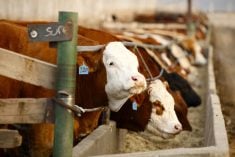(Resource News International) — Total Canadian pork product exports are expected to slip in 2009 due to production declines in the Canadian hog sector.
“Because hog production will go down in 2009, the best we can think of is to maintain the same levels as last year but realistically we may have to expect a 10 per cent reduction,” said Jacques Pomerleau, executive director of Canadian Pork International in Ottawa.
That should correspond to an anticipated 10 per cent reduction in Canadian hog production this year as a result of the livestock liquidation that has taken place in North America due to depressed hog prices.
Read Also

U.S. livestock: Cattle futures drop on Trump call for lower prices
Cattle futures on the Chicago Mercantile Exchange dropped sharply on Wednesday, reacting to comments from United States President Donald Trump…
Total Canadian pork product exports are forecast at one million tonnes in 2009, down from 1.094 million tonnes in 2008 but similar to the 2007 export levels.
The main export destinations will be mostly unchanged, with the U.S. in the No. 1 spot followed by Japan, China/Hong Kong and South Korea. Russia is also expected to remain in the top five markets but the big unknown is how much it will import this year compared to 2008.
“Last year Canada was banned completely for two months from Russia but we were able to get back into that market. In the end we had an excellent year but I don’t think we can repeat that,” Pomerleau said.
Not only has the global economic slowdown hurt Russian purchasing power but a number of Canadian processing plants are not approved for pork shipments to Russia.
In regards to exports as a whole, Pomerleau said the exchange rate of the Canadian dollar will be have the biggest impact on Canada’s ability to sell its pork products abroad.
“The Canadian dollar fluctuates from day to day and it has been very volatile. That hurts Canadian exporters because most international trade is done in U.S. dollars,” he said.











